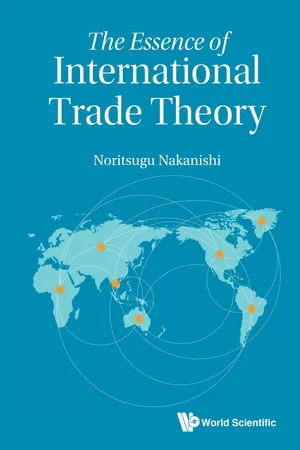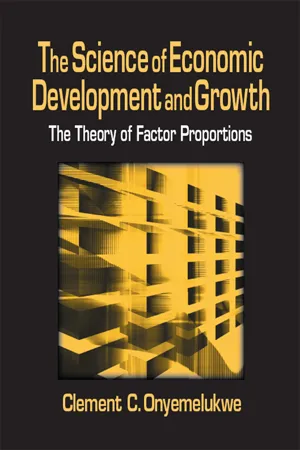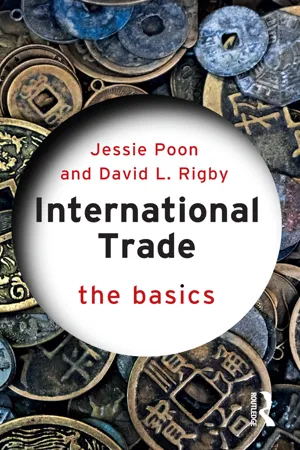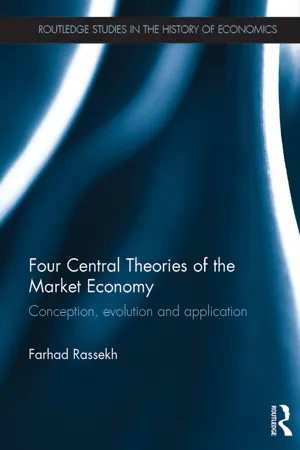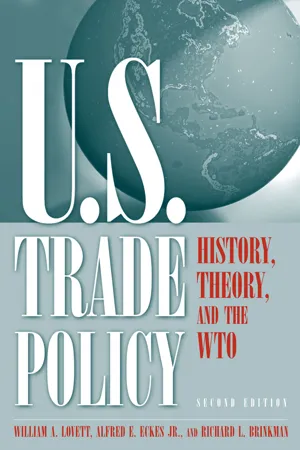Economics
Comparative Advantage
Comparative advantage refers to a country's ability to produce goods or services at a lower opportunity cost than another country. This concept is based on the idea that countries should specialize in producing goods or services in which they have a comparative advantage, and then trade with other countries to obtain goods and services in which they have a comparative disadvantage.
Written by Perlego with AI-assistance
Related key terms
5 Key excerpts on "Comparative Advantage"
- eBook - ePub
- Noritsugu Nakanishi(Author)
- 2018(Publication Date)
- WSPC(Publisher)
Chapter 2
Basics of Comparative Advantage
When the relative price of a good in one country is lower than in other countries, the first country is said to have a Comparative Advantage in this good over other countries.1 Differences in the relative prices are, among others, the most important driving force of international trade. A country will export its products to foreign markets where prices are higher than in its own markets and, conversely, import goods and services from foreign markets where prices are lower than in its own markets. In this way, there emerges a trade pattern — a description of which country imports or exports what kind of goods and services. Therefore, the first step to examine the structure of international trade is to show how the differences in relative prices across countries are determined. In this chapter, we first introduce a simple trade model called the Ricardian model, which highlights the roles of the differences in production technology as one of the determinants of Comparative Advantage. Then, we extend and generalize it into several different directions.2.1Technology and Behavior of Firms
Consider a world economy consisting of two countries (A and B), two goods (good 1 and good 2), and one primary production factor called labor. Goods are produced by using only labor as inputs under constant-returns-to-scale (CRS) technologies. The production technology characterized by both a single production factor and CRS is called the Ricardian technology. Free entry–exit of firms is also assumed.For the moment, we concentrate on the situation in one of the countries. In general, production functions and other variables introduced below depend not only on the identities of goods but also on the identities of countries to which they belong. Unless necessary, we omit explicit indications of the identities of countries from the variables. - eBook - ePub
The Science of Economic Development and Growth: The Theory of Factor Proportions
The Theory of Factor Proportions
- C.C. Onyemelukwe(Author)
- 2016(Publication Date)
- Routledge(Publisher)
5 International Trade Versus Economic Development and Growth This chapter examines the contribution, if any, international trade can make to economic development and growth. Trade: Comparative AdvantageMost economists support trade and regard it as an important vehicle for economic development and growth. In general, trade is supposed to allow each country to specialize in those things it does best and let others provide it with those things in which it is not best.In order for trade to pass the test as a vehicle of economic development and growth, it is necessary that the definition of “best” and the criteria for selecting those things a country does best have valid scientific credentials and that when countries trade on this basis they do in fact witness growth.The essential concept that has dominated economic history in this analysis is that of Comparative Advantage. Krugman and Obstfeld quoted Samuelson as having described Comparative Advantage as the best example known of an economic principle that is “undeniably true.”1 A country is said to have a Comparative Advantage in producing a good if the opportunity cost of producing that good in terms of other goods is lower in that country than it is in other countries. David Ricardo’s idea of Comparative Advantage was based on international differences in productivity of labor. So a country was best at producing a good if the labor needed to produce it there was less than anywhere else. Because any economy has limited resources, it is argued that there are limits on what it can produce. The total labor in the economy is said to set the limits of production. In the Ricardian model, it is claimed that a country will, in a trade-off, produce those things in which the prices are equal to their opportunity cost and the relative prices of goods are equal to their relative labor requirements.There are already problems here. Ricardo did not concern himself with how the goods he was talking about are made. Each of them requires a certain combination of capital, material, and labor to produce. It is obvious that for the unit of goods he has in mind, the one in which the labor proportion is least, will be said to have been produced with less labor and so come out on top in terms of Ricardo’s Comparative Advantage. It seems that the Ricardian model is biased toward techniques requiring low labor input techniques. As we have already shown, however, a country’s growth potential is maximized when the factor proportions of all activities are equal to the economy’s factor endowments, and what is required is equal factor proportions for all activities. Whereas in the Ricardian model, which assumes an economy is unbalanced, labor supply is said to place a limit on the economy’s production, in the new economy we have in mind, labor does not set a limit because the factor proportions, from which production techniques are determined, are based on the economy’s supply of labor. - eBook - ePub
International Trade
The Basics
- Jessie Poon, David L. Rigby(Authors)
- 2017(Publication Date)
- Routledge(Publisher)
This raises the question of whether country A would benefit from trade with country B; after all, it is more efficient at producing both goods. Ricardo’s model of Comparative Advantage establishes that the answer to this question is yes, so long as the opportunity cost of producing wine relative to wheat varies between the two countries. It is then straightforward to show that free trade will generate gains for both countries if each of them specializes in producing the commodity where they hold the greatest Comparative Advantage, the commodity where their opportunity costs are minimized. Figure 2.1 Illustration of Comparative Advantage Assume that trade opens up between our two countries. As before, we assume that they are neighbors and thus transport costs are zero. When the flow of goods between countries is first allowed, the relative prices of our two commodities will vary inside each country; they will take time to adjust. Enterprising individuals will see these price differentials and attempt to profit from them in a process known as arbitrage, buying a commodity at a low price in one location and selling it for a higher price somewhere else. For example, one unit of cloth in country B might be exchanged for three units of wine. These three units of wine might then be moved to country A and exchanged for cloth such that a profit of two units of cloth is realized. Alternatively, producers of cloth in country A will recognize that at pre-trade prices they can exchange one unit of cloth for one unit of wine. However, if they sell their wine at pre-trade prices in country B they will receive three units of wine for each unit of cloth. Flows of cloth and wine will grow in volume between the two countries altering patterns of supply and demand such that a uniform or world price of wine relative to cloth will be established. To identify this world price requires information on the specific patterns of demand for cloth and wine in each of our two countries - eBook - ePub
- Farhad Rassekh(Author)
- 2016(Publication Date)
- Routledge(Publisher)
The demand function in this context represents the various units of imports a country is willing to exchange with her exports. 43 The farther the terms of trade is from a country's production cost of imports (measured in terms of forgone exports), the larger the gains from trade. This analysis implies that under free trade, a small (poor) country (that is, a price-taker in world markets) benefits more than a large (rich) trade partner because the terms of trade would be closer to the cost (price) ratio of the large country and thus (relatively) farther from that of the small country. 44 This result would be reversed if the large country imposed a tariff on its imports from the small country, against which the small country cannot retaliate because she imports too little. 45 This theory sowed the seeds of the optimum tariff argument. 46 4 Comparative Advantage and free trade The economic case for free trade rests on two deductively derived propositions: first, free trade leads countries to the production of the goods in which they have a Comparative Advantage; second, production based on Comparative Advantage results in efficient resource allocation. Hence free trade maximizes efficiency and the gains from trade. Indeed, the theory of Comparative Advantage provides a powerful case for free trade. 47 Historically, however, support for free trade did not always rest on Comparative Advantage. In fact, the classical economists from Ricardo to J. S. Mill usually invoked the theory of Comparative Advantage not to justify free trade but to explain why trade takes place among all countries. Moreover, when they did advance a case for free trade they often resorted to the type of arguments we encounter in the Wealth of Nations. Even Ricardo, in making a case for free trade, advanced an argument reminiscent of Smith's invisible-hand passage in the Wealth of Nations - eBook - ePub
U.S. Trade Policy: History, Theory, and the WTO
History, Theory, and the WTO
- William A. Lovett, Alfred E. Eckes, Jr, Richard L. Brinkman(Authors)
- 2015(Publication Date)
- Routledge(Publisher)
Contrary to conventional wisdom and textbook mythology, Adam Smith actually placed the domestic economy and its advance over the international: “According to the natural course of things, therefore, the greater part of the capital of every growing society is, first, directed to agriculture, afterwards to manufactures and last of all to foreign commerce” (Smith 1937, 352, 360, 423; and Irwin 1996, 84). And further, that acquired absolute advantage rests with the industrialization of the domestic economy: “Most opulent nations, indeed, generally excel all their neighbours in agriculture as well as in manufactures, but are commonly more distinguished in the latter than in the former” (Smith 1937, 6; Bloomfield 1994, 111; 1975, 457). Once having acquired absolute advantages inherent in the processes of modern economic growth and industrialization, it is then prudent for a nation to compete in global markets, and from this to gain the benefits of a larger market size, improved productivity, and further technological advances.Certainly, this has been the historic path pursued by Britain and the United States. The Japanese pursued a similar development path, applying policies of a developmental state, which has also served as the model pursued by the “tigers” of East Asia.12 “In short they adopted the Japanese approach—’competing out and protecting in,’” and thereby “insulating their domestic economies … from foreign competition” (Yergin and Stanislaw 1998, 159, 180).But assuming an absolute advantage in both industrial and agrarian pursuits, whether natural or acquired, why then should a nation engage in trade and import goods produced less efficiently abroad? This question was alleged to be outside the boundaries of Smith’s matrix. It led to the introduction of Ricardo’s doctrine of comparative costs. By comparison, the framework of comparative costs explains that it is possible in some circumstances to benefit from importing a good that is more costly in its production abroad— a possibility supposedly overlooked by Smith, but recognized by Ricardo. Ricardo’s static theory of comparative cost ratios will be discussed and critiqued later in this chapter.The second leg of Smith’s theory of trade, the vent-for-surplus theory, was stressed by Hlya Myint as perhaps more relevant and the better framework to be applied in relating classical trade theory (Myint 1958). In allowing a vent-for-surplus production, exports and free trade permit a nation to advance and improve its position on its efficiency locus, better known as the production-possibility or transformation curve. The vent-for-surplus reasoning accounts for a movement from unemployed to fully employed resources at zero opportunity costs. The vent-for-surplus theory, however, also can serve to support the dumping of surplus goods abroad, with frequent disruptive impacts upon other nations.
Learn about this page
Index pages curate the most relevant extracts from our library of academic textbooks. They’ve been created using an in-house natural language model (NLM), each adding context and meaning to key research topics.
